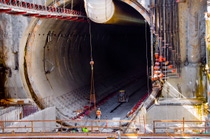Media
One small step for chemistry—one giant leap for American tunnel construction
BASF contributes to Seattle's largest tunnel build-out.

The city of Seattle is marking a momentous occasion this week --opening to traffic the massive SR-99 tunnel and highway through (and under) its downtown area. (Photos: Catherine Bassetti Photography)

History has been made, and BASF played a small but significant part in it.
Seattle’s infamous two-mile-long tunnel underneath its downtown area to replace the city’s State Route 99 Alaska Way Viaduct has finally been completed, opening to traffic in February 2019. While it’s been a long road, “Bertha,” the largest tunnel boring machine (TBM) at the time that it was built, has been digging beneath the city, and reached the end of its journey back in April 2017. It took four years after Bertha embarked on the job to break through on the opposite end of the tunnel, excavating, approximately 28 dump-truck loads of soil every 25 minutes during the height of its operation. TBM's are typically named after a local celebrity. Bertha was named after Seattle's mayor—Bertha Knight Landes—who was breaking a different type of ground back in the 1920s as the first female mayor of a major city.
The Emerald City’s project to replace the aging infrastructure—a major North/South connection through its downtown area—has been a work in progress for the last decade. The 60-year-old structure has been suffering from decades of wear and tear, along with the effects of population growth and congestion. The new double-deck highway tunnel along Seattle's waterfront will help alleviate congestion and better the traffic flow through the downtown area, increase public access to the waterfront and enhance access to commerce. Additionally, the new structure will improve seismic resilience in the event of a substantial earthquake.
While many might know about this five-story-tall tunnel undertaking, few are aware that BASF contributed several primary products. BASF’s solutions are well-suited for Earth Pressure Balance tunneling, to not only seal the TBM from incoming water and soil, but also to condition the soils for efficient excavation.
Below are some of the BASF Master Builders Solutions product technologies that contributed to help move the tunneling to a successful completion:
- Soil conditioners—Earth Pressure Balance tunneling requires the correct use of soil conditioners to reduce cutter-head torque and increase advance rates (the TBM moving forward in the tunnel). The more efficiently it advances, the quicker the project can be completed.
- Tail sealant greases—They are used for sealing against water, soil and annulus grout ingress into the TBM.
- Annulus grout admixtures—When the segmental lining, made of precast concrete segments, is built inside the TBM, the space between the ground and the segments is called the annulus gap. BASF provided retarders used in the grouting process to affect the setting time of the grout.
- Polymer injection systems—Injection grouting near the end of the tunnel drive was used for ground consolidation and water control to prevent water ingress into the tunnel and at the portal.
- Precast concrete segments admixtures—High-performance concrete additives were used to ensure durability and efficient production of the precast concrete segments, such as the MasterGlenium® superplasticizer, MasterFinish®, finish-enhancing admixture and MasterLife®, silica fume mineral admixture.
“We’re very excited to have been part of the world’s largest diameter tunnel,” said Jim Lindsay, Regional Business Segment Manager, Construction Chemicals N.A., BASF. “The sheer magnitude of the project was a technical and logistical challenge, and BASF’s specialized tunneling expertise and logistical infrastructure made it possible to effectively meet the challenges of this landmark project.”
The SR-99 project is a collaboration and investment of both public and privare sectors, as well as a mix of several projects for the benefit of residents and the successful growth of Seattle.
Tunneling technology is one way that BASF creates chemistry for a sustainable future—helping cities improve infrastructure for future generations.
Watch the video below from The Atlantic Summit on Infrastructure and Transportation underwritten by BASF and GM titled "Breaking Through – A Transformation in Seattle" that took place last year in Washington, D.C.
Published by Anna Spiewak.
For media inquiries or to repurpose this article, please contact Lisa Brown.